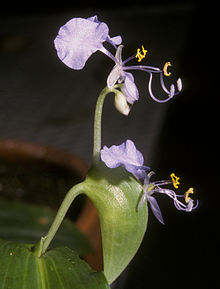Commelina lukei
| Commelina lukei | |
|---|---|

| |
| Male and bisexual flowers, on a plant grown from a cutting of William Richard Quentin Luke's collection. | |
| Scientific classification | |
| Kingdom: | Plantae |
| Clade: | Tracheophytes |
| Clade: | Angiosperms |
| Clade: | Monocots |
| Clade: | Commelinids |
| Order: | Commelinales |
| Family: | Commelinaceae |
| Genus: | Commelina |
| Species: | C. lukei
|
| Binomial name | |
| Commelina lukei | |
Commelina lukei is a
Taxonomy
Commelina lukei was previously confused with the similar species Commelina imberbis. While a number of
Commelina lukei had been informally recognised as a distinct species for some time, particularly when it was observed in the field because floral characters could be observed. A thorough study of the plant had not been undertaken until the time shortly before the species' publication. Robert B. Faden, the author of the paper describing the species, noted that he realised C. lukei was a new species upon collecting it in 1969, but was unable to distinguish dried herbarium specimens of the plant from the two aforementioned similar species. Eventually Faden noticed that certain specimens had needle-like, acicular hairs along the midvein on the leaves' upper surfaces, while others had mainly or only hook-hairs. Once sorted into two piles based on this character, Faden noticed that the plants with needle-like hairs also had all of their leaves clasping the stem, appendaged seeds, and capsules with a bulging apex, while those with hook-hairs only had leaves towards the tip clasping, unappendaged seeds, and broader capsules lacking an apical bulge. These characters proved sufficient for consistently separating both live and herbarium specimens.[1]
Neither Commelina imberbis nor Commelina mascarenica is most closely related to Commelina lukei. A third similar species, Commelina kotschyi, which has itself been frequently confused with C. imberbis, shares the most features with C. lukei. Both have appendaged seeds and bulging capsule apices, but C. kotschyi is an annual, has smaller leaves with undulate margins, smaller spathes that lack an upper cincinnus, and mostly hook-hairs along the upper surface of the midvein. Additionally C. kotschyi is found in upland areas in seasonally waterlogged soils and the distributions of the two species only overlap in a narrow strip.[1]
Robert Faden chose the
Distribution and habitat
Commelina lukei is found in tropical
The species is found in a wide variety of habitats that are typically found at elevations between sea level and 1000 metres, though one collection was made as high as 1700 metres. It has been collected in a variety of woodland habitats, typically in more open settings such as forest edges, forest clearings, plantations, and open areas of mountain forests, but also in lowland evergreen forests and within woodlands. It has also been found in thickets and bushland as well as in more open habitats such as grasslands and roadsides. Additionally it has occurred along riversides and is sometimes associated with rocks in moist situations.[1]
References
- ^ S2CID 85947947
- ^ Faden, Robert B. (2008), "Commelina mascarenica (Commelinaceae): An overlooked Malagasy species in Africa" (PDF), Adansonia, 3, 30 (1): 47–55, archived from the original (PDF) on 2011-06-12, retrieved 2009-01-14

